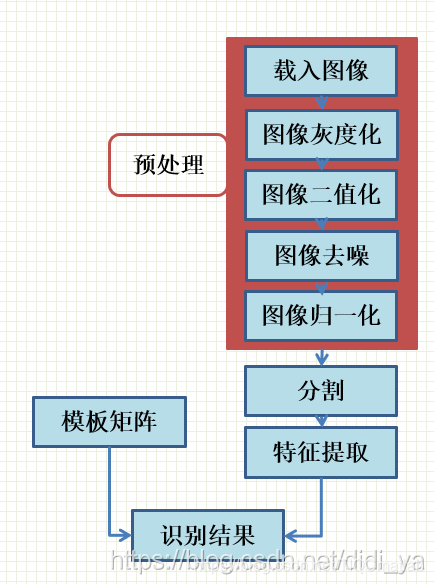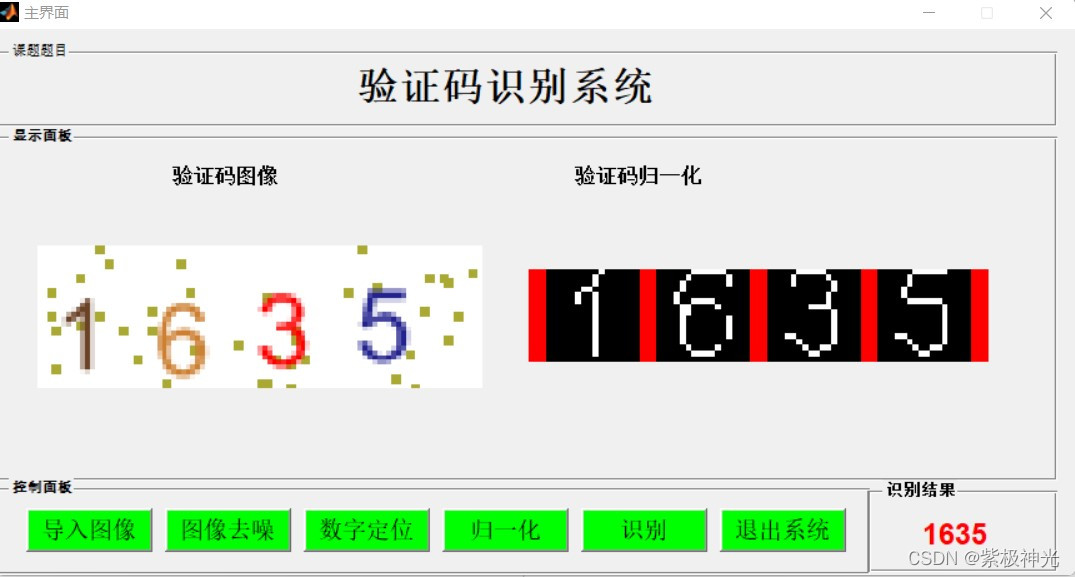【验证码识别】基于matlab GUI不变矩验证码识别(带面板)【含Matlab源码 095期】
一、不变矩验证码识别简介
1 背景意义
验证码具有多变性特点,而当前的识别系统往往具有很强的针对性, 只能够识别某种类型的验证码。随着网络安全技术及验证码生成技术的不断发展,已经出现了更加复杂的验证码生成方法,如基于动态图像的验证码系统等。运用计算机视觉、模式识别等相关理论对多种不同类型的验证码进行识别研究。矩特征主要表征了图像区域的几何特征,又称为几何矩, 由于其具有旋转、平移、尺度等特性的不变特征,所以又称其为不变矩。
2 理论基础
本案例提出了以处理颜色加噪的数字字符为理论研究素材, 将模板匹配作为基本框架的验证码识别系统。本系统的优点在于能够对特定类型的数字验证码进行精确识别,实验中识别准确率可达到95%以上,并提供动态更新样本库的功能,可根据实际运行的环境提高验证码的识别率。
本案例选择了经典的数字验证码识别作为识别的对象。验证码的识别涉及图像预处理、分割、特征提取、识别等相关技术,本案例通过对彩色验证码图像进行灰度化、二值化、去噪和归一化等步骤来进行预处理,通过建立模板库的动态更新机制来提高系统的兼容性,进一步提升验证码识别的效率和准确性。
流程图如下:

3 算法流程
为了进行验证码识别, 建立模板库建立动态模板库,加入自动更新的功能提高对数字验证码的识别率。数字验证码待识别对象即数字0 ~ 9,调用mkdir 函数来自动建立模板数据库文件夹。
由于图中有类似于椒盐噪声的带有颜色的噪声,数字验证码中的数字个数保持常量并且分布均匀、易于分割。因此,为了进行下一步的数字分割操作,需要先进行验证码图像去噪步骤。本案例采用颜色空间转换到hsv 的方式,用阈值过滤的手段进行去噪。进行图像去噪之后,可以发现验证码图像中的数字呈现分布均匀的状态,并且未明显受到倾斜、形变等因素的影响。借用数字图像二值化、积分投影的方式可对数字进行定位。在实际处理过程中,为了保证分割有效,加入了区域面积滤波操作,将剩余的噪声点进行滤除。为了进行下一步的识别操作,需要将分割结果进行归一化处理, 整合成固定维数的数字集合。数字图像分割完成后,通过提取数字图像的不变矩特征信息,与模板库中的数字图像
进行对比,得到识别结果。
二、部分源代码
function varargout = daunxujian1(varargin)
% DAUNXUJIAN1 MATLAB code for daunxujian1.fig
% DAUNXUJIAN1, by itself, creates a new DAUNXUJIAN1 or raises the existing
% singleton*.
%
% H = DAUNXUJIAN1 returns the handle to a new DAUNXUJIAN1 or the handle to
% the existing singleton*.
%
% DAUNXUJIAN1('CALLBACK',hObject,eventData,handles,...) calls the local
% function named CALLBACK in DAUNXUJIAN1.M with the given input arguments.
%
% DAUNXUJIAN1('Property','Value',...) creates a new DAUNXUJIAN1 or raises the
% existing singleton*. Starting from the left, property value pairs are
% applied to the GUI before daunxujian1_OpeningFcn gets called. An
% unrecognized property name or invalid value makes property application
% stop. All inputs are passed to daunxujian1_OpeningFcn via varargin.
%
% *See GUI Options on GUIDE's Tools menu. Choose "GUI allows only one
% instance to run (singleton)".
%
% See also: GUIDE, GUIDATA, GUIHANDLES
% Edit the above text to modify the response to help daunxujian1
% Last Modified by GUIDE v2.5 23-Oct-2020 21:52:34
% Begin initialization code - DO NOT EDIT
gui_Singleton = 1;
gui_State = struct('gui_Name', mfilename, ...
'gui_Singleton', gui_Singleton, ...
'gui_OpeningFcn', @daunxujian1_OpeningFcn, ...
'gui_OutputFcn', @daunxujian1_OutputFcn, ...
'gui_LayoutFcn', [] , ...
'gui_Callback', []);
if nargin && ischar(varargin{1})
gui_State.gui_Callback = str2func(varargin{1});
end
if nargout
[varargout{1:nargout}] = gui_mainfcn(gui_State, varargin{:});
else
gui_mainfcn(gui_State, varargin{:});
end
% End initialization code - DO NOT EDIT
% --- Executes just before daunxujian1 is made visible.
function daunxujian1_OpeningFcn(hObject, eventdata, handles, varargin)
% This function has no output args, see OutputFcn.
% hObject handle to figure
% eventdata reserved - to be defined in a future version of MATLAB
% handles structure with handles and user data (see GUIDATA)
% varargin command line arguments to daunxujian1 (see VARARGIN)
% Choose default command line output for daunxujian1
handles.output = hObject;
handles.Result = [];
handles.File = [];
% Update handles structure
guidata(hObject, handles);
clc; warning off all;
InitAxes(handles);
% UIWAIT makes daunxujian1 wait for user response (see UIRESUME)
% uiwait(handles.figure1);
% --- Outputs from this function are returned to the command line.
function varargout = daunxujian1_OutputFcn(hObject, eventdata, handles)
% varargout cell array for returning output args (see VARARGOUT);
% hObject handle to figure
% eventdata reserved - to be defined in a future version of MATLAB
% handles structure with handles and user data (see GUIDATA)
% Get default command line output from handles structure
varargout{1} = handles.output;
% --- Executes on button press in pushbutton1.
function pushbutton1_Callback(hObject, eventdata, handles)
% hObject handle to pushbutton1 (see GCBO)
% eventdata reserved - to be defined in a future version of MATLAB
% handles structure with handles and user data (see GUIDATA)
[filename, pathname] = uigetfile({'*.jpg;*.tif;*.png;*.gif','All Image Files';...
'*.*','All Files' },'载入图像',...
fullfile(pwd, 'images'));
I = imread(fullfile(pathname, filename));
Result = Process_Main(I);
handles.File = fullfile(pathname, filename);
handles.Result = Result;
guidata(hObject, handles);
InitAxes(handles)
axes(handles.axes1); imshow(handles.Result.Image); title('原图像');
% --- Executes on button press in pushbutton2.
function pushbutton2_Callback(hObject, eventdata, handles)
% hObject handle to pushbutton2 (see GCBO)
% eventdata reserved - to be defined in a future version of MATLAB
% handles structure with handles and user data (see GUIDATA)
if ~isempty(handles.Result)
axes(handles.axes1); imshow(handles.Result.Image); title('原图像');
axes(handles.axes2); imshow(handles.Result.Medfilt); title('中值滤波图像');
end
% --- Executes on button press in pushbutton3.
function pushbutton3_Callback(hObject, eventdata, handles)
% hObject handle to pushbutton3 (see GCBO)
% eventdata reserved - to be defined in a future version of MATLAB
% handles structure with handles and user data (see GUIDATA)
if ~isempty(handles.Result)
axes(handles.axes1); imshow(handles.Result.Image); title('原图像');
axes(handles.axes2); imshow(handles.Result.Medfilt); title('中值滤波图像');
axes(handles.axes3); imshow(handles.Result.Normalize); title('归一化图像');
end
% --- Executes on button press in pushbutton4.
function pushbutton4_Callback(hObject, eventdata, handles)
% hObject handle to pushbutton4 (see GCBO)
% eventdata reserved - to be defined in a future version of MATLAB
% handles structure with handles and user data (see GUIDATA)
if ~isempty(handles.Result)
axes(handles.axes1); imshow(handles.Result.Image); title('原图像');
axes(handles.axes2); imshow(handles.Result.Medfilt); title('中值滤波图像');
axes(handles.axes3); imshow(handles.Result.Normalize); title('归一化图像');
axes(handles.axes4); imshow(handles.Result.Bww); title('二值化图像');
end
% --- Executes on button press in pushbutton6.
function pushbutton6_Callback(hObject, eventdata, handles)
% hObject handle to pushbutton6 (see GCBO)
% eventdata reserved - to be defined in a future version of MATLAB
% handles structure with handles and user data (see GUIDATA)
if ~isempty(handles.Result)
axes(handles.axes1); imshow(handles.Result.Image); title('原图像');
axes(handles.axes2); imshow(handles.Result.Medfilt); title('中值滤波图像');
axes(handles.axes3); imshow(handles.Result.Normalize); title('归一化图像');
axes(handles.axes4); imshow(handles.Result.Bww); title('二值化图像');
axes(handles.axes6); imshow(handles.Result.Thin); title('细化处理');
axes(handles.axes5); imshow(handles.Result.Bw); title('特征提取');
hold on;
h = [];
for i = 1 : length(handles.Result.hs) %绘制水平线
h = [h plot([1 handles.Result.sz(2)], [handles.Result.hs(i) handles.Result.hs(i)], 'r-')];
end
for i = 1 : length(handles.Result.vs)%绘制竖直线
h = [h plot([handles.Result.vs(i) handles.Result.vs(i)], [1 handles.Result.sz(1)], 'g-')];
end
h = [h plot(handles.Result.x1, handles.Result.y1, 'y-')];%绘制左对角线
h = [h plot(handles.Result.x2, handles.Result.y2, 'm-')];%绘制右对角线
end
% --- Executes on button press in pushbutton7.
function pushbutton7_Callback(hObject, eventdata, handles)
% hObject handle to pushbutton7 (see GCBO)
% eventdata reserved - to be defined in a future version of MATLAB
% handles structure with handles and user data (see GUIDATA)
[filename, pathname] = uiputfile({'*.jpg;*.tif;*.png;*.gif','All Image Files';...
'*.*','All Files' },'Save Image',...
fullfile(pwd, 'Result/result.png'));
if ~isequal(filename, 0)
imwrite(handles.Result.label, fullfile(pathname, filename));
msgbox('保存图像成功!', '信息提示框');
end
% --- Executes on button press in pushbutton9.
function pushbutton9_Callback(hObject, eventdata, handles)
% hObject handle to pushbutton9 (see GCBO)
% eventdata reserved - to be defined in a future version of MATLAB
% handles structure with handles and user data (see GUIDATA)
choice = questdlg('确定退出?', ...
'退出', ...
'是','否','否');
switch choice
case '是'
close;
otherwise
return;
end
function edit1_Callback(hObject, eventdata, handles)
% hObject handle to edit1 (see GCBO)
% eventdata reserved - to be defined in a future version of MATLAB
% handles structure with handles and user data (see GUIDATA)
% Hints: get(hObject,'String') returns contents of edit1 as text
% str2double(get(hObject,'String')) returns contents of edit1 as a double
% --- Executes during object creation, after setting all properties.
function edit1_CreateFcn(hObject, eventdata, handles)
% hObject handle to edit1 (see GCBO)
% eventdata reserved - to be defined in a future version of MATLAB
% handles empty - handles not created until after all CreateFcns called
% Hint: edit controls usually have a white background on Windows.
% See ISPC and COMPUTER.
if ispc && isequal(get(hObject,'BackgroundColor'), get(0,'defaultUicontrolBackgroundColor'))
set(hObject,'BackgroundColor','white');
end
% --- Executes on button press in pushbutton8.
function pushbutton8_Callback(hObject, eventdata, handles)
% hObject handle to pushbutton8 (see GCBO)
% eventdata reserved - to be defined in a future version of MATLAB
% handles structure with handles and user data (see GUIDATA)
set(handles.edit1,'string',handles.Result.label);
% --- Executes on button press in pushbutton10.
function pushbutton10_Callback(hObject, eventdata, handles)
% hObject handle to pushbutton10 (see GCBO)
% eventdata reserved - to be defined in a future version of MATLAB
% handles structure with handles and user data (see GUIDATA)
if ~isempty(handles.Result)
axes(handles.axes1); imshow(handles.Result.Image); title('原图像');
axes(handles.axes2); imshow(handles.Result.Medfilt); title('中值滤波图像');
axes(handles.axes3); imshow(handles.Result.Normalize); title('归一化图像');
axes(handles.axes4); imshow(handles.Result.Bww); title('二值化图像');
axes(handles.axes6); imshow(handles.Result.Thin); title('细化处理');
end
- 1
- 2
- 3
- 4
- 5
- 6
- 7
- 8
- 9
- 10
- 11
- 12
- 13
- 14
- 15
- 16
- 17
- 18
- 19
- 20
- 21
- 22
- 23
- 24
- 25
- 26
- 27
- 28
- 29
- 30
- 31
- 32
- 33
- 34
- 35
- 36
- 37
- 38
- 39
- 40
- 41
- 42
- 43
- 44
- 45
- 46
- 47
- 48
- 49
- 50
- 51
- 52
- 53
- 54
- 55
- 56
- 57
- 58
- 59
- 60
- 61
- 62
- 63
- 64
- 65
- 66
- 67
- 68
- 69
- 70
- 71
- 72
- 73
- 74
- 75
- 76
- 77
- 78
- 79
- 80
- 81
- 82
- 83
- 84
- 85
- 86
- 87
- 88
- 89
- 90
- 91
- 92
- 93
- 94
- 95
- 96
- 97
- 98
- 99
- 100
- 101
- 102
- 103
- 104
- 105
- 106
- 107
- 108
- 109
- 110
- 111
- 112
- 113
- 114
- 115
- 116
- 117
- 118
- 119
- 120
- 121
- 122
- 123
- 124
- 125
- 126
- 127
- 128
- 129
- 130
- 131
- 132
- 133
- 134
- 135
- 136
- 137
- 138
- 139
- 140
- 141
- 142
- 143
- 144
- 145
- 146
- 147
- 148
- 149
- 150
- 151
- 152
- 153
- 154
- 155
- 156
- 157
- 158
- 159
- 160
- 161
- 162
- 163
- 164
- 165
- 166
- 167
- 168
- 169
- 170
- 171
- 172
- 173
- 174
- 175
- 176
- 177
- 178
- 179
- 180
- 181
- 182
- 183
- 184
- 185
- 186
- 187
- 188
- 189
- 190
- 191
- 192
- 193
- 194
- 195
- 196
- 197
- 198
- 199
- 200
- 201
- 202
- 203
- 204
- 205
- 206
- 207
- 208
- 209
- 210
- 211
- 212
- 213
- 214
- 215
- 216
- 217
- 218
- 219
- 220
- 221
三、运行结果

四、matlab版本及参考文献
1 matlab版本
2014a
2 参考文献
[1] 蔡利梅.MATLAB图像处理——理论、算法与实例分析[M].清华大学出版社,2020.
[2]杨丹,赵海滨,龙哲.MATLAB图像处理实例详解[M].清华大学出版社,2013.
[3]周品.MATLAB图像处理与图形用户界面设计[M].清华大学出版社,2013.
[4]刘成龙.精通MATLAB图像处理[M].清华大学出版社,2015.
文章来源: qq912100926.blog.csdn.net,作者:海神之光,版权归原作者所有,如需转载,请联系作者。
原文链接:qq912100926.blog.csdn.net/article/details/112461513
- 点赞
- 收藏
- 关注作者


评论(0)